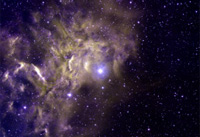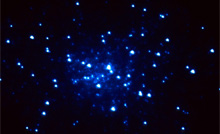|
|
| Illuminating some mysteries of the cosmos with FUSE |
|
|
Light—especially, the non-visible kind—can tell us a lot about the origin and evolution of distant stars and galaxies. The Far Ultraviolet Spectroscopic Explorer telescope (FUSE) peers deep into space to capture the ultraviolet light from celestial objects such as
- massive stars
- supernovae
- active galactic nuclei and quasars
- planetary nebulae
- the outer atmospheres of cool stars and planets

An illustration of the FUSE satellite on an infrared image of the Carina Nebula, a region of intense star formation which has been the subject of intense study by FUSE. (Source: NASA)
| Many cosmic objects also give off UV light that astronomers can use to probe the thin gas between stars and galaxies, known as the interstellar medium.
"The analysis of FUSE observations by more than 400 scientists around the world is providing new insights into our understanding of the universe," says Dr. John Hutchings, the Canadian project scientist for FUSE at the Herzberg Institute of Astrophysics. Canada and France are NASA's partners in the mission that launched in 1999. |

The FUSE satellite control centre at Johns Hopkins University. (Source: NASA) |
Enigma 1: Deuterium
Recently, FUSE helped solve a 35-year-old mystery about deuterium. "This result is a testament to the determination and effort of the entire team. It's a legacy of the mission," says George Sonneborn, the NASA project scientist for FUSE.

FUSE helped solve the mystery of why deuterium levels vary throughout the cosmos. In regions with a lot of interstellar dust, such as near the star AE Aurigae, deuterium can "stick" to dust particles where it cannot be detected. (Source: T.A. Rector and B.A. Wolpa, NOAO, AURA, and NSF.) |
Deuterium is a heavy form of hydrogen that was created a few minutes after the Big Bang, but is depleted by the nuclear processes that power stars. Scientists track its depletion so they might better understand early conditions and how long stars have been active.
Measurements taken since the 1970s have varied widely from one part of the cosmos to another. Low levels found in some regions can be explained by the FUSE findings. Deuterium in undisturbed parts of the cosmos may bind with interstellar dust grains that change it from an easily detectable gas into a solid form that can't be detected. FUSE observed higher levels of deuterium near supernovae and hot stars whose heat could vaporize dust grains and release deuterium. |
Enigma 2: The Milky Way corona
FUSE confirmed a theory that our galaxy, the Milky Way, is surrounded by a large halo of superheated gas created by stars that exploded long ago. Its observations also revealed that the halo is larger than expected, and could be hiding as much as 100 million solar masses of matter, more than 33 trillion times the mass of the Earth.
| Enigma 3: Not-so-hot stars The temperature scale for the hottest, brightest stars has been revised down by 20 to 25 percent based on FUSE measurements. Since the stars are cooler than previously thought, it means they are also less massive and give off less light. The findings provide new insights into the energy balance of galaxies, the amount of heating radiation in the universe, and star formation. This has an impact on our understanding of the evolution of our universe. |

FUSE observations revealed that the hottest stars are up to 25 percent cooler than previously thought, providing new insights into the energy balance of galaxies.
(Source: NASA) |
A team that refuses to fail
Innovative ideas to address equipment problems have been tested on this mission. When devices that stabilize and point the telescope failed, the team found creative solutions to keep FUSE working. They now use the satellite's electromagnets for pointing the telescope by interacting with the Earth's magnetic field. The guidance camera contributed by Canada has also proven itself very useful in the face of adversity. It was reprogrammed to monitor satellite drift by tracking a star moving across the field of view.
"We now we have a spacecraft with a minimum of moving parts. This has never been done before," says Dr. Hutchings. "It may change spacecraft design."
For more information on the FUSE mission, please see the Canadian Space Agency's
mission Web page.
|
